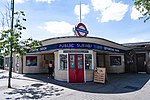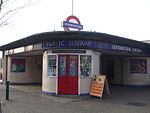Green Man, Leytonstone
LeytonstonePubs in the London Borough of Waltham ForestTransport in the London Borough of Waltham Forest

The Green Man is a pub and road junction on High Road, Leytonstone, London. The pub has been rebranded as part of the O'Neill's chain. The current 1920s building replaced an earlier public house, close to the original site; which was built around 1668 and mentioned by Daniel Defoe. A statue called Leaf Memory by Stephen Duncan was erected in 2001 at Grove Road and High Road in Bushwood depicting the Green Man sat with head lowered in his arms.
Excerpt from the Wikipedia article Green Man, Leytonstone (License: CC BY-SA 3.0, Authors, Images).Green Man, Leytonstone
High Road Leytonstone, London Leytonstone (London Borough of Waltham Forest)
Geographical coordinates (GPS) Address Nearby Places Show on map
Geographical coordinates (GPS)
| Latitude | Longitude |
|---|---|
| N 51.570555555556 ° | E 0.015555555555556 ° |
Address
O'Neill's
High Road Leytonstone 762
E11 3AW London, Leytonstone (London Borough of Waltham Forest)
England, United Kingdom
Open on Google Maps










